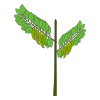Butter beans, also known as lima beans, are a type of legume that are appreciated for their creamy texture and slightly sweet flavour. They are typically large, flat, and have a pale green or white colour, depending on the variety. Butter beans are incredibly versatile in the culinary world and can be found both in dried and canned forms.
Nutritionally, butter beans are a powerhouse of benefits. They are rich in dietary fibre, which aids in digestion and helps maintain healthy cholesterol levels. Additionally, they are a great source of protein, making them a popular choice among vegetarians and vegans. Butter beans are also packed with essential nutrients such as potassium, iron, and magnesium.
In cooking, butter beans can be used in a wide range of dishes. They are commonly added to soups and stews to provide a hearty and satisfying element. When cooked, they have a creamy texture that makes them ideal for purees or as a base for vegetarian patties. Butter beans also work well in salads, providing a nutritious and filling component.
Their mild flavour means they easily absorb the tastes of the ingredients they are cooked with, making them a favourite for dishes that are rich in spices and herbs. Whether simmered in a savoury broth, blended into a smooth dip, or simply sautéed with garlic and olive oil, butter beans add a delightful texture and nutritional boost to meals.
How To Grow
Growing butter beans, also known as lima beans, can be a rewarding gardening project. Here’s a step-by-step guide on how to cultivate these nutritious legumes:
-
Choose the Right Variety
Select a variety of butter beans suited to your climate. Bush varieties are more compact and generally easier to manage, while pole varieties need support but can yield more beans over a longer period.
-
Prepare the Soil
Butter beans thrive in well-draining soil with a pH between 6.0 and 6.8. Work the soil to a depth of about 8-12 inches and enrich it with compost or aged manure to improve fertility and structure.
-
Sowing Seeds
Plant butter beans after the last frost when the soil has warmed to at least 65°F (18°C). Sow seeds about 1-2 inches deep and 3-6 inches apart. If planting rows, keep them about 18-24 inches apart.
-
Watering
Water the plants regularly to keep the soil consistently moist but not waterlogged. Butter beans are somewhat drought tolerant, but adequate moisture is crucial during flowering and pod formation.
-
Supporting
If you’re growing pole varieties, provide sturdy supports like trellises or stakes at planting time to support the vines as they grow.
-
Weeding
Keep the garden bed free from weeds, which compete with your plants for nutrients and water. Mulching around the plants can help suppress weeds and retain soil moisture.
-
Dealing with Pests and Diseases
Monitor for common pests such as aphids and bean beetles. Use organic pesticides if necessary. Avoid overhead watering to reduce the risk of fungal diseases like bean blight.
How/When To Harvesting
Harvesting butter beans, also known as lima beans, at the right time ensures you get the most flavour and the best texture from your beans. Here’s a detailed guide on how to harvest them:
-
Timing the Harvest
Butter beans are typically ready for harvesting approximately 60 to 90 days after planting, depending on the variety and growing conditions.
To determine if the beans are ready for harvest, look for pods that are firm and have a slight bulge, indicating the beans inside are fully developed but not overly mature.
-
Checking Pod Maturity
Gently feel the pods while they are still on the plant. Pods should be plump, and you should be able to feel the outline of the beans inside. If the pods are still smooth and the beans inside are not distinguishable, give them more time to mature.
-
Picking the Pods
Harvest the pods by hand, picking them off the plant gently to avoid damaging the vine. It’s helpful to use two hands—one to hold the vine and the other to pluck the pod. This is especially important for pole varieties that continue producing over time.
Regular harvesting encourages the plant to produce more beans. Try to pick every few days once the beans start maturing.
-
Harvesting for Fresh Beans
If you plan to eat the beans fresh or cook them shortly after picking, harvest the pods when the beans inside are fully formed but before they start to harden. This stage is when the beans are most tender and sweet.
-
Harvesting for Dry Beans
If you prefer dry beans for storage, allow the pods to remain on the plant until they are dry and the beans inside rattle when shaken. The pods will turn a light brown or tan colour, and the leaves of the plant may start to yellow and die back.
After picking, dry the pods further in a warm, dry place if needed, then shell the beans and store them in an airtight container.
-
Storage
Fresh beans can be kept in the refrigerator for about a week. For longer storage, they can be blanched for three minutes, cooled in ice water, drained, and then frozen.
Dried beans should be stored in a cool, dry place in an airtight container, where they can last for several years.


